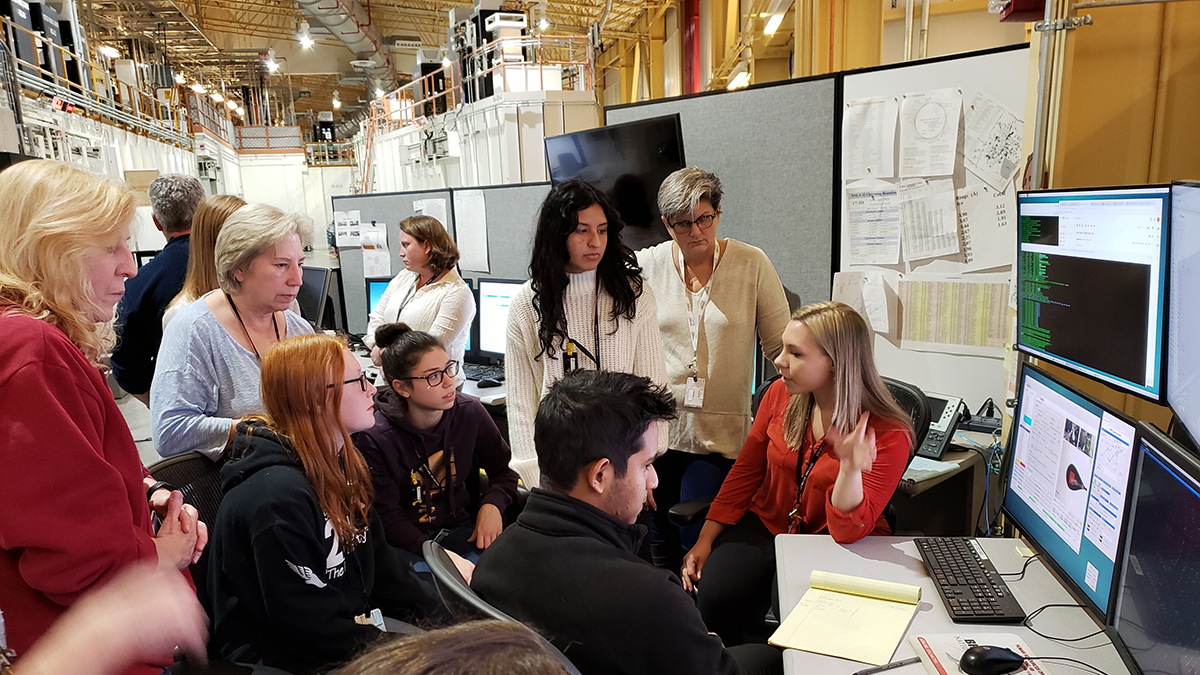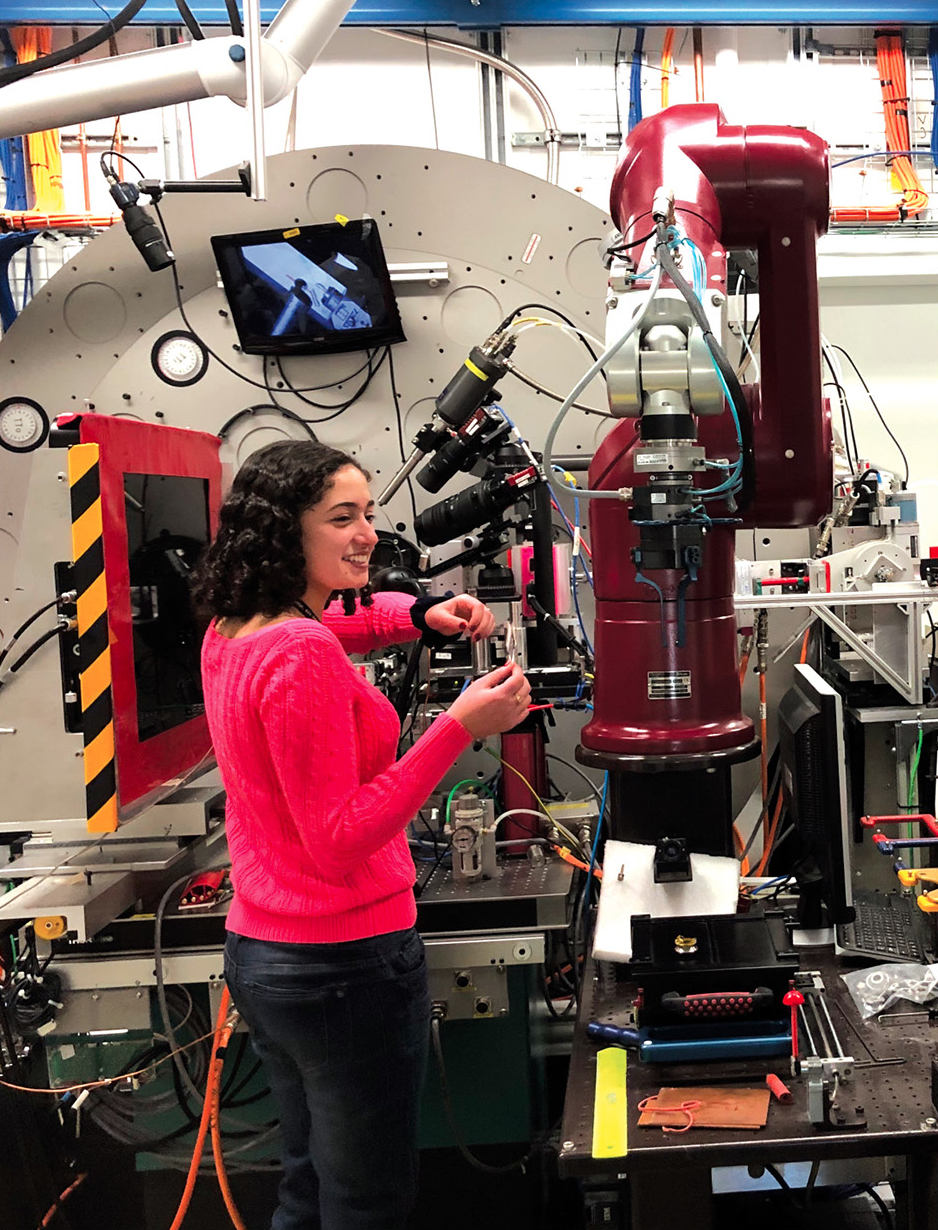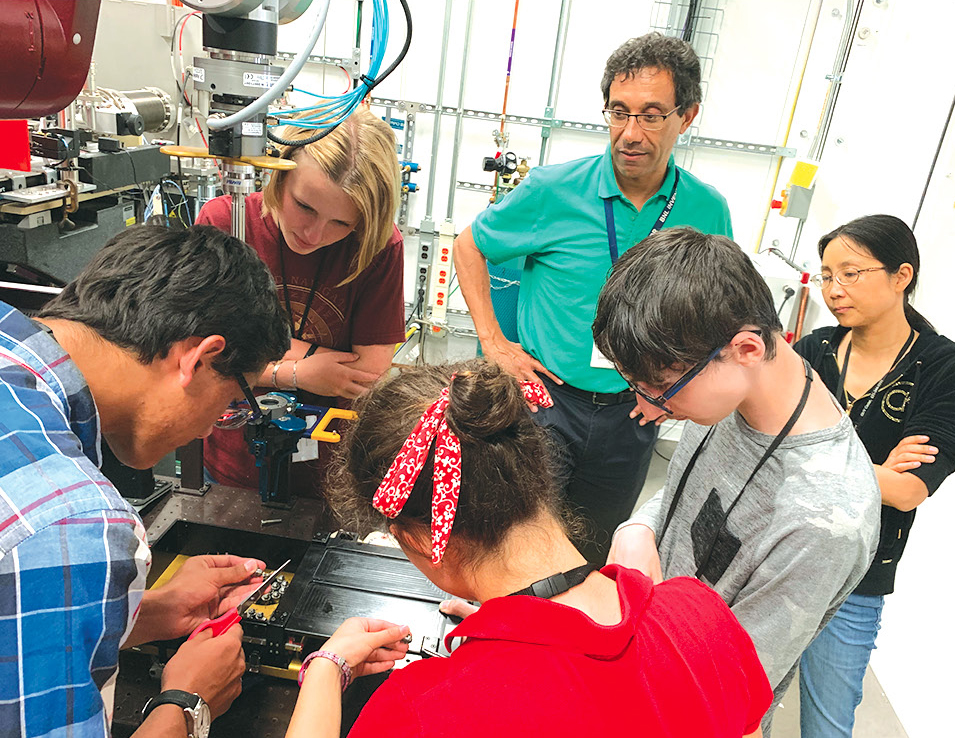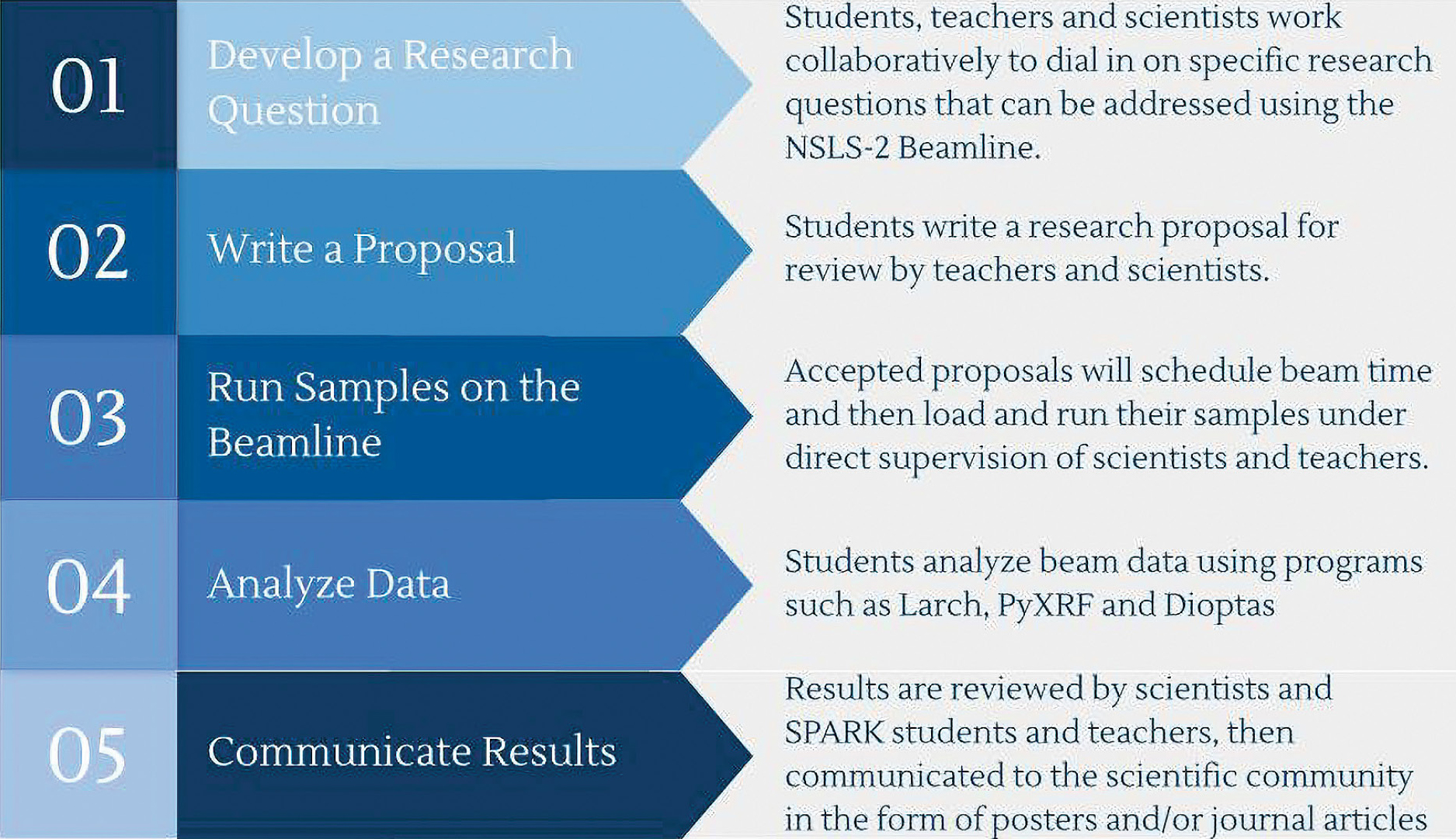feature
Collaboration Crushes Competition!
Preparing High School Research Students for Success in Big Science Careers
The Science Teacher—July/August 2021 (Volume 88, Issue 6)
By Lucinda Hemmick, Dame Forbes, Robert Bolen, Mary Kroll, Dianna Gobler, John Halloran, Vivian Stojanoff, and Aleida Perez

Some high school science students now have access to new sophisticated research tools using synchrotron radiation and other instruments not found in a typical high school setting. Students use these tools to collaborate on projects in a variety of disciplines with support from classroom teachers and scientists. Access to these tools advances NSTA’s position on quality science and 21st-century science skills, including engaging students in real-world problem-solving, critical thinking, and opportunities to investigate and build scientific explanations (NSTA 2011). Such real-life, hands-on opportunities allow students—who would not normally interact with their teachers and scientists in such a collaborative way—a unique learning experience that builds scientific confidence and curiosity and could help inspire a future generation of scientists.
Sounds great—but wait a minute. This access brings with it a new set of issues. How can students learn about the specialized capabilities of these tools? How will they discern the best ways to apply the tools to their specific research questions, and make best use of the limited time they will be granted? How will students learn to collaborate in large, multischool groups? How can students learn to use state-of-the-art computational tools to analyze the big data generated by their projects (Sneider 2014)? How can teachers discern which portions of the projects the students may safely perform at the facility, using techniques of active learning to promote interest in STEM careers? How will these experiences enrich students and inform the science research curricula studied by students in high school? (Bell et al. 2003). In this article, we will explore some answers to these questions by sharing student experiences with Student Partnerships for Advanced Research and Knowledge (SPARK), our new collaborative program at Brookhaven National Laboratory (BNL). The SPARK program is designed to promote student research at BNL’s National Synchrotron Light Source II (NSLS II) with the guidance of their high school teachers, BNL educational leaders, and BNL scientific mentors.
New Technologies Lead to New Questions
The mission of Star Trek’s Enterprise is to “boldly go where no one has gone before.” Exposing students to new and cutting-edge technologies is even more thrilling as this unique exposure allows for their imagination and scientific interest to collide in the most practical way. In the SPARK program, students and teachers are given a tour of Brookhaven National Labs (BNL) and the National Synchrotron Light Source II (NSLS II), and meet some of the scientists who built and operate the instruments. They are then given opportunities to examine the features of each beamline to spark a personal interest into designing their own scientific question.
The SPARK program is a collaborative effort led by scientist-educators at BNL. Dr. Aleida Perez of the BNL Office of Educational Programs supervises the program, which allows students from Long Island high schools to perform hands-on research at the NSLS II. Students are guided by teachers and BNL scientific mentors while they write experimental proposals requesting the use of specific NSLS II beamlines. A beamline is a set of equipment that focuses an x-ray beam on a sample being studied in a room scientists call a hutch. The x-rays reveal the sample’s structure and composition. Available beamlines include those capable of elucidating protein crystal structure (AMX, FMX, NYX, and LIX), analyzing chemical compositions of samples (IR), revealing mineral composition (XPD and XFM), and analyzing and mapping elemental composition (SRX, TES, and XFM).
Students gain unique real-life research experience as they move through the process of developing and submitting competitive proposals for using the equipment. Before submitting proposals, students must complete mandated online training in BNL facility regulations, laboratory safety, and cybersecurity. Students may be required to complete additional training based on the beamlines they wish to use. Proposals from students must conform to the same rules applied to outside scientists requesting beam time at the NSLS II.

Submitting proposals into the BNL PASS system (Proposal Allocation, Safety, and Scheduling) offers high school students an authentic experience in competing for scarce resources. To coordinate all SPARK projects, a Block Allocation Grant (BAG) mechanism is used so that all approved projects receive a shared block of time at each beamline requested. The process of submitting proposals requires SPARK students to
- collaborate with peers, teachers, and scientific mentors to refine a research question;
- investigate the technical capabilities of each beamline to determine which beamline(s) are most appropriate to use for their sample analysis;
- conduct an extensive scientific literature search to inform their proposals and support the validity of the research question;
- design a properly controlled experiment;
- describe how samples will be prepared appropriately for the specifications of each beamline;
- demonstrate time-management skills by requesting an appropriate number of shifts at each beamline and access to necessary tools;
- exhibit an appreciation for established safety protocols at BNL and at specific beamlines; and
- develop communications skills with peers, teachers, and scientist mentors.

Proposals are reviewed by BNL scientists and by a committee formed by researchers outside the community. If proposals are approved, students and their teachers are notified and submit a Safety Approval Form (SAF) outlining the safety controls necessary for performing the experiment. The proposal and safety approval process teaches students to carefully plan and prepare for the safety and experimental aspects well in advance.
Once students develop a research question, they must compete in the same competitive proposal process that all scientists from around the world who wish to use the instrument must use. Students and teachers collaborate with a team of SPARK mentor scientists to present their ideas and get advice and revisions before they proceed with the proposal process. This is done in a supportive environment that fosters growth in the students and challenges the students to use scientific literature and their growing knowledge of the beamlines to design appropriate questions.
Many of the research questions the students propose relate to the NGSS standards such as design, evaluation, and finding solutions for environmental issues and biodiversity (HS-LS2-7) involving both disciplinary core ideas (DCI) and science and engineering practices (SEP). The technical limitations of each beamline are also examined and students gain understanding in engineering design as they pose possible solutions to problems. Most exciting is watching and listening to the interactions between the scientists, teachers, and students, as every voice is heard and respected. It is a great way to encourage new scientists.

Asking Good Questions
We often tell our students that there are no bad questions. Perhaps that statement can be qualified a bit when it comes to proposing a new scientific research question. In SPARK, students must match their research questions to the capabilities (and limitations) of the beamlines available. This requires a thorough understanding of the technology. Once students have convinced themselves that they will be using the right beamline for the experiment, they must address other concerns such as correct sample preparation, adequate number of samples, and positive/negative controls.
The overarching goal of designing a good experiment now comes into play. Studies have shown that even when partnered with science mentors, students have persistent struggles with good experimental design (Bell et al. 2003) Our approach has been to ground the SPARK collaborative groups in basic design concepts, and then assess their success by reviewing their research proposal details. Students are encouraged to think to the end of their projects, and to design their experiments in such a way that a peer-reviewed publication might still be achieved, no matter which way the data leads. Attention is paid to ensuring that the information gained when using the beamlines justifies the time spent. Because students are free to ask research questions in any field, crosscutting concepts (CCCs) commonly emerge in our collaborative work (National Research Council 2012).
Collaboration, Not Competition
In recent years, there has been a gradual shift away from individual student research projects toward collaborative projects (where teams of students present group results and all share in rewards such as scholarships and prizes). The many advantages of collaborative work include improving the important social skills of better listening, avoiding negative judgments on new ideas, and valuing diverse input from students outside the specialized field of the experiment. One student commented: “SPARK has allowed me to meet so many like-minded passionate students. The scope of imagination that SPARK broadens through science is truly thrilling.”

SPARK students learn that working with a team requires trusting others, and that the goal of the experiment is not to win science competitions, but rather to contribute meaningfully to the field by publishing results in peer-reviewed journals. BNL considers all research performed there to be in the public domain, serving as a valuable introduction to the concept of public research versus proprietary research.
During the course of the entire experiment, as SPARK students move through the phases of designing experiments, submitting proposals, collecting samples, performing measurements, and analyzing data, they are constantly engaged in both SEPs and Computer Supported Collaborative Science (CSCS) (Herr and Rivas 2014). Collaborative work across several school districts lends itself to virtual data analysis and online group meetings, which have allowed us to proceed normally in our research progress even during the Covid-19 restrictions. Students experience their value as individual contributors to the group effort, as each student’s strength contributes to the success of the team.
Introducing Students to the Competitive Grant Review Process
Students in SPARK must compete with other users of the facility for allotted times at each beamline. This experience serves as a valuable introduction to the bread and butter of the scientific researcher: consistent success in securing research grants. Students are supplied with the NSLS II grant proposal template and deadlines for proposals. Teachers and scientists advise and encourage students as they formulate their experimental plan. Writing the competitive proposal draws upon many NGSS components, such as the students’ literature research skills (Julien and Barker 2009), designing experiments (Bell et al. 2003), and producing evidence-based arguments (NGSS Lead States 2013). As students attempt to justify their requests for beamline shift time, they must hone their time-management skills. Descriptions of sample collection and preparation reveal whether students fully appreciate the technical specifications of each beamline.
A premium is placed on student safety at BNL, which requires online training as well as training at each beamline. This process puts the focus on each student’s responsibilities for maintaining safe research practices (National Research Council 2006). Depending on which beamline is listed in the proposal, students must certify completion of all necessary institutional safety training courses for that beamline.
Finally, the proposal process itself emphasizes perhaps the most valuable skill set in scientific research: creativity in proposing novel research approaches and collaborative problem solving to answer important scientific questions (Isaksen, Dorval, and Treffinger 2010). <<Figure5>>

Big Data Needs Big Computing Skills!
SPARK experiments result in the generation of large, complex data sets which must be critically analyzed and interpreted. When considering how well high school students are prepared in their coursework to analyze large experimental data sets, it is important to realize that high school courses in computer science are not necessarily courses emphasizing scientific computing. An educational gap exists between learning how to program and applying this learning to NGSS standards of computational thinking (Weintrop et al. 2016; Sneider et al. 2014). Even students who are facile in many programming skills must be trained in practical applications of these skills before they can begin meaningful contributions to modern laboratory research (Rafalski et al. 2019).
To close this gap, some research facilities have begun offering their own scientific computing courses as well as advocating for their inclusion in high school curricula. To meet this need locally, a representative from BNL’s Information Technology Department has volunteered over the past several years to travel to many Long Island schools, including several SPARK collaborating schools, to teach a 10-week course in Scientific Computing. Curriculum-expanding opportunities exist for high schools to create scientific computing courses designed to directly relate basic computational skills to problem solving and data analysis in scientific investigations (Bienkowski 2016).
The core challenge lies in teaching high school students how to use their existing computational tools to analyze novel data in a discerning fashion. SPARK’s projects require students to use elements of Python and other languages to translate raw data into meaningful experimental results. Students must develop an appreciation for the fine details of how data analysis routines perform analysis on data sets, and how to best use analysis programs to extract the experimental information needed to answer their research questions convincingly. Even before data is generated, students begin with the challenge of learning the programming environment for steering the beam or communicating with robotic sample changers at the beamlines. After data is generated, students participate in a hands-on fashion by downloading spectrum analysis programs such as Larch, PyXRF, and Dioptas on their own computers, and using the routines to analyze shared experimental data.
These processes call into practice the SEPs of asking questions and analyzing/interpreting data. SPARK students must construct the experiment correctly using the capabilities of each beamline, relate the data analysis to their specific research questions, and correctly interpret how the data supports or refutes their hypotheses. Teacher/scientist/student interactions regarding experimental design and sample selection/preparation help to refine the experimental approach, and support both student and teacher learning of SEP principles (Duschl and Bybee 2014).
After data is generated and analyzed, students proceed to the SEPs of arguing from evidence (NGSS Lead States 2013), and they communicate the evidence they have obtained with their collaborating peers, teachers, and scientists. For each student to make a meaningful contribution, all students must become familiar with the data analysis process (including its capabilities and limitations) for each beamline’s data set. SPARK was fortunate to have an online analysis and virtual meeting protocol in place even before the Covid-19 restrictions closed our schools briefly in the spring of 2020; this structure allowed us to continue to proceed in our research.
Finally, because the end goal of scientific research is to communicate results to the public, the end goal of each SPARK project lies in submitting the results to a research journal for peer-reviewed publication. Thus far, SPARK has generated one accepted journal paper (Esposito 2020) and has several more manuscripts currently in preparation. In addition, new protein structures from protein crystallization experiments have resulted in several new Protein Data Bank (PDB) entries (6PEY and 6UEV, Gallagher et al. Fothcoming; Jannotta et al. Forthcoming).

Assessment of Program Success and Opportunities for New Programs
Based on our positive experiences with the SPARK program, we would like to encourage other national laboratories to consider initiating similar programs locally to open the door to high school students. These programs represent a win/win experience for all students, teachers, and scientists. We have received positive feedback from the scientists working with SPARK regarding their interactions with our students and teachers. The scientists enjoy the enthusiasm, novel approaches, and new research ideas delivered by the students. SPARK teachers benefit through training in practicing real-world scientific research, mentoring students, and being mentored by the scientists. These experiences can be directly applied by teachers to enrich curricula in both science research classes and general science classes.
One teacher commented: “SPARK gave me the opportunity to create a research curriculum with feedback from fellow teachers and students which will help accelerate the development of research skills.” The application of remote data analysis and virtual meetings across different school districts has been excellent preparation for our student researchers, who will likely find themselves using these tools in their future research careers. Student success in SPARK has been assessed using the accepted measuring tools of publishing peer-reviewed scientific articles, contributing new PDB entries, and presenting results at symposia.
Anonymous SPARK exit surveys show that students’ experiences in SPARK have inspired their selection of STEM-related majors in college. SPARK students also return to BNL as college research interns. We believe that SPARK and other programs based on SPARK will contribute directly to the generation of new career scientists positioned to advance future research in our country.
Acknowledgments
We would like to acknowledge the SPARK program collaboration for their curiosity in exploring research topics. We acknowledge Scott Bronson and Ken White of the Brookhaven National Laboratory Office of Educational Programs for their support of the SPARK Program. We acknowledge the National Synchrotron Light Source-II at Brookhaven National Laboratory and the scientists who have assisted with projects, especially Dr. Paul Northrup, Dr. Juergen Thieme, Dr. Lisa Miller, Dr. Eric Dooryhee, Dr. Daniel Olds, Dr. Kevin Battiale, Dr. Ryan Pappero, Dr. Yonghua Du, Dr. Seongmin Bak, Dr. James Byrnes, and Dr. Alex Soares. The NSLS-II is a user facility funded by the Department of Energy, Office of Science. We thank past and present high school teachers involved in SPARK for coordinating research efforts. We acknowledge the following school districts for supporting SPARK student and teacher participation: Bay Shore School District, Carle Place School District, Connetquot School District, Eastport-South Manor Central School District, Harborfields Public Schools, Hauppauge Public School District, Huntington Public Schools, Islip School District, Long Beach Public Schools, Longwood Central School District, Middle Country Central School District, Northport-East Northport Schools, Plainedge Public Schools, Sachem Central School District, Sayville Public Schools, Shelter Island School District, Shoreham-Wading River Central School District, West Islip Public Schools, Westhampton Beach School District, and William Floyd School District. ■
Online Connections
Lucinda Hemmick (lucinda.hemmick@longwoodcsd.org) is a teacher at Longwood High School in Middle Island, NY. Dame Forbes (dforbes@hufsd.edu) is a teacher at Huntington High School in Huntington, NY. Robert Bolen (BolenR@esmonline.org) is a teacher at Eastport-South Manor Junior-Senior High School in Manorville, NY. Mary Kroll (M.Kroll@wi.k12.ny.us) is a teacher at West Islip High School in West Islip, NY. Dianna Gobler (goblerd@whbschools.org) is a teacher at Westhampton Beach High School in Westhampton Beach, NY. John Halloran (johnhalloran07@gmail.com) is a teacher at Connetquot High School in Bohemia, NY. Vivian Stojanoff (stojanof@bnl.gov) is a scientist/educator at the National Synchrotron Light Source II, Brookhaven National Laboratory in Upton, NY. Aleida Perez (pereza@bnl.gov) is a scientist/educator in the Office of Educational Programs, Brookhaven National Laboratory in Upton, NY.
Chemistry Physics Science and Engineering Practices STEM High School


